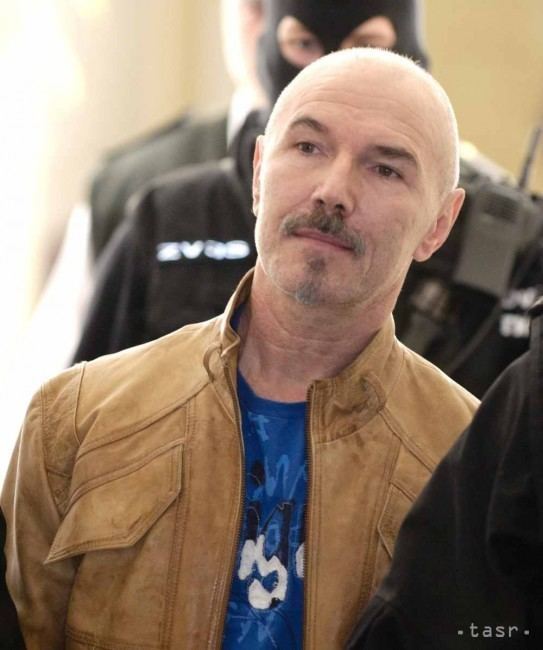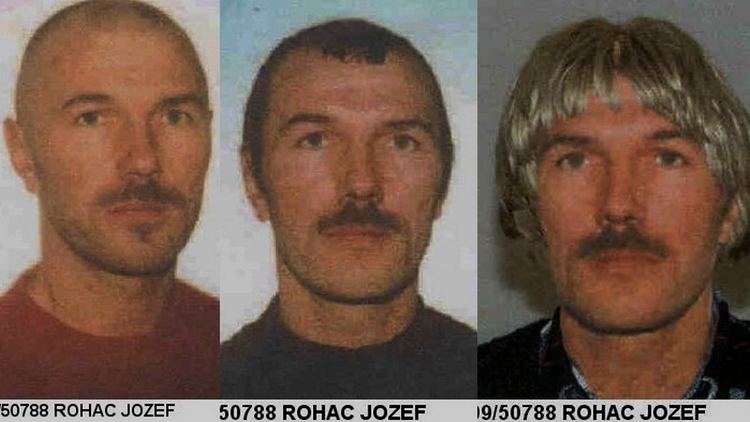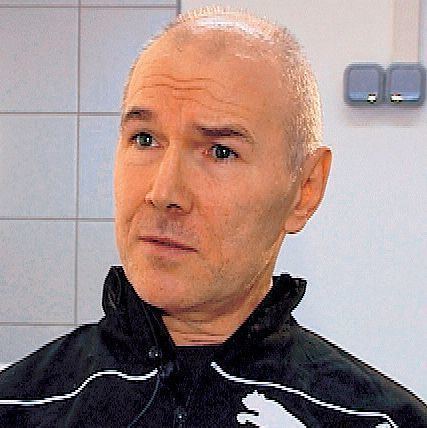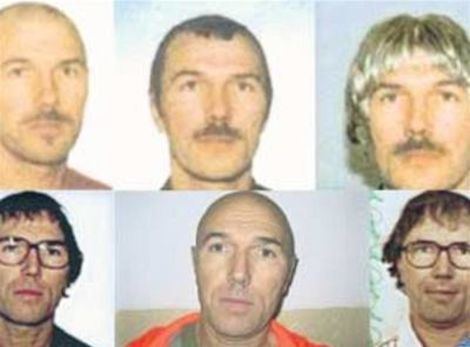 | ||
Jozef Roháč a.k.a. Potkan (September 6, 1956) is a Slovak criminal, terrorist and mafia hitman, specializing in explosives. He is mostly known for installing the explosive device in the Assassination of Róbert Remiáš and in assassinations of numerous organized crime bosses in Slovakia and Hungary. According to newspaper SME, Roháč had at some point connections to both the Slovak and Hungarian Secret Services. Despite international search by the Interpol, he managed to evade the law for 9 years.
Contents
- Name
- Early life
- Career under communism
- Leopoldov prison mutiny
- Assassination of Rbert Remi
- Assassination of Eduard Dini
- Assassination of Tams Boros
- Other notable crimes
- Legal issues
- In culture
- References

A career criminal for most of his life, in 1984 Roháč was sentenced to 15 years for terrorism under communist Czechoslovakia for kidnapping the Deputy Minister of Health and attempting to take him out of the country. Later, he became the first prisoner ever to escape from Ilava prison. Soon re-captured, he became one of the organizers of the 1989 Leopoldov Prison mutiny. He was released in 1990 because of a wide-ranging amnesty by President Václav Havel.

In April 2011, Jozef Roháč was extradited to Hungary, where he faced charges for multiple assassinations: Ferenc Domák pander in 1996, János Fenyö media magnate in 1998, and Tamás Boros maffia boss in 1998. In the latter crime 3 bystanders were also killed in the explosion. In March 2016 the attorney requested lifetime imprisonment for Roháč in a joint trial of his crimes.

Name

Jozef Roháč is identified in the Slovak media as Potkan (English: Rat), his other alias being Čiapočka (English: Little hood). The following identities have been used by Roháč in the past: Josef Fink; Miloš Lukáč (before 1989); Milan Lupták.
Early life

Jozef Roháč was born in Levice, Czechoslovakia and as of today, he still has his official residence listed here. He was one of five siblings and his father was an alcoholic, who beat the children, although not very often. In his own words, his childhood was not particularly happy and he used to get often into fights. Later, he started a career of petty crime: "fights, alcohol, badmouthing the communist regime, policemen and suspended sentences" recalls Roháč in the early 1990s.
Career under communism

Jozef Roháč committed his first high-profile crime in 1985, in communist Czechoslovakia, when armed, he kidnapped the Deputy Minister of Health in order to negotiate the crossing of the border to escape from the country.
He was 29 years old at that time, having just finished serving the compulsory military service in Czechoslovakia. After officially asking for the permit to travel to Austria, Roháč was openly speaking about staying there. His permit was denied and two policemen came to his home and confiscated his passport. Together with a friend he obtained two guns and they both stumbled upon the Deputy Minister of Health Kováč, kidnapping him immediately. They got stuck, however at the Petržalka-Berg border crossing, where they were surrounded by the police.
Jaroslav Toman, husband of future Minister of Labour of Slovakia Viera Tomanová, who worked as a high ranking police officer in Bratislava at that time was one of the engaging policemen and Roháč's bullet allegedly missed him only narrowly. Toman's witness account served as a basis to accuse Roháč of the intent to kill, which Roháč denied. For his actions, Toman was awarded a medal for protecting the borders of the Czechoslovak Socialist Republic. Despite the whole incident was declared a state secret, Toman immediately told his wife. The story was broken by TV JOJ in 2008. When interviewing Tomanová, she declared that her husband was scared of Roháč for the rest of his life and that her whole family was threatened at that time.
Jozef Roháč was sentenced to 15 years for terrorism, starting his sentence in Ilava. He became the only person under communism ever to escape from Ilava prison, earning him respect among other prisoners. He was eventually re-captured and another four years in prison were added on top of his original sentence. During his subsequent stay in prison, he started writing poetry. He claims he was regularly beaten in Leopoldov Prison.
Leopoldov prison mutiny
Jozef Roháč was one of the organizers of the Leopoldov Prison mutiny in 1990 and he was one of the few prisoners to negotiate directly with the Federal Minister of Interior at that time, Ján Langoš.
Already notorious and respected prisoner because of his successful escape from Ilava prison, Jozef Roháč bolstered his reputation also by an incident where he was brutally beaten by prison guards after talking to some prisoners, yet he refused to even tell them who he was speaking with.
After his release from Leopoldov Prison, Roháč continued his criminal career. A short time after being released, he helped his brother privatize some buildings using coercion, an act he admitted in a later interview.
Over the years, Roháč became known in the Slovak underground as an expert on explosive devices. He earned a reputation of professionalism in planning, preparation, realization and evidence removal and he was known to have a 100% success rate (although there is at least one publicized case of one of his explosive devices falling off the car allowing the target to survive).
Assassination of Róbert Remiáš
Róbert Remiáš, an ex-police officer, was the person through which Oskar Fegyveres communicated in a key political lawsuit of the 1990s Slovakia. Fegyveres was an ex-secret agent who gave testimony in the case of kidnapping of the son of the President of Slovakia, Michal Kováč, Jr., into Austria. Fegyveres described the involvement of Prime Minister Vladimír Mečiar and Director of Slovak Information Service Ivan Lexa in this crime. As of 1996, Fegyveres was already in hiding and communicated only through his close friend, Róbert Remiáš.
The Deputy Director of Slovak Information Service Jaroslav Svěchota gave the order to assassinate Remiáš to the boss of Bratislava mafia at that time, Miroslav Sýkora. Svěchota knew Sýkora personally, both men met regularly. According to the original lawsuit, Sýkora delegated the hit to Jozef Roháč and Imrich Oláh. According to the head of investigators at that time, they were helped by two other unidentified men, one of them a member of the Slovak Information Service. Roháč placed an explosive device under Remiáš's car, attaching it at the rear axle. The car exploded on Karloveská Street in Karlova Ves, Bratislava on April 29, 1996. The explosion did not kill Remiáš immediately, as evidenced by fumes found in his lungs and witness accounts of hearing him scream, but he did die shortly after.
Bratislava regional prosecution, complying with the investigator, dropped the charges against Jozef Roháč and Imrich Oláh in 2006 in relation to the murder of Róbert Remiáš.
Assassination of Eduard Dinič
On May 9, 1998 an explosion equivalent to 5 kilograms of TNT killed local crime boss Eduard Dinič near Zlaté piesky in Bratislava, some minutes before 8 p.m. Dinič was considered to be head of one of the most powerful groups in the Bratislava mafia. The Diničovci group were known best for their racketeering business and for their part in the Privatization in Slovakia under Prime Minister Vladimír Mečiar. Dinič was aware his life was in danger and he was already preparing to go into hiding and on this day, he wanted to go play tennis for the last time before heading out of the country. Roháč placed the explosives underneath concrete tiling of the narrow pavement leading to the tennis courts where Dinič was known to cross. The device was remotely detonated at the very moment that Dinič was above. Pieces of human tissue were collected by the police from the radius of 150 meters and the blast created a hole several meters deep.
According to Slovak police pyrotechnic Miroslav Gona, who was attending the crime scene, the killer must have been nearby, at a place where he could see the scene clearly. The explosive device was detonated remotely using probably a pager, remote control from garage doors or a mobile phone, but those were still not widespread in Slovakia at that time. According to Gona, the device was at least 1 meter underneath the pavement which suggests large-scale construction work at this place. Apparently, no one noticed the preparation.
In December 1999, Slovak police interrupted investigation in this case. According to Alena Toševová from the Regional Police Directorship in Bratislava, "investigation was interrupted because there were no findings allowing to press charges against any individuals". Slovak investigators were not able to find out what kind of explosive device was used. It has to be noted that this placement of explosives is unique in Slovakia, in all prior mafia hits using explosives, the device was always placed in the car of the victim or in a car parked nearby.
Assassination of Tamás Boros
On July 2, 1998, Roháč assassinated local mafia boss Tamás Boros in Budapest. Roháč placed the explosives underneath a Fiat vehicle parked outside Aranykéz Street No. 2 in the center of the city. The device exploded when Boros was nearby, killing not only him, but also 3 unconnected bystanders (including a 24-year-old woman) and injuring 20 - 25 others including foreign nationals. It was the first time in the history of Hungary that innocent bystanders died in mafia activities. The Budapest Police Headquarters suspected Jozef Roháč and other gang members of committing the attack, however the investigation ended in 2002 as it failed to provide evidence.
Other notable crimes
Legal issues
Jozef Roháč was arrested in Hungary in 2008 on charges of attempted assassination of businessman Zoltan Seres in June 1997 and finished serving his sentence in October 2010. Roháč's fingerprints were found on the device that dislodged from the bottom of Seres' car and failed to go off. The police could not secure enough evidence for prosecutor to push for a prepared execution of Zoltan Seres, which would carry much higher sentences, he was only sentenced to 2 years in prison and 3 years of being persona non grata in Hungary. Roháč was released on October 26, 2010.
After his release from prison, a DNA sample taken back in 2008 was finally matched with samples left behind by the suspected assassin of Hungarian media mogul János Fenyö in 1998. On May 4, 2011 the Chief Prosecutor's Office in Budapest has launched an inquiry into delays in identifying the DNA after recently refusing to accept an explanation by the National Bureau of Investigation. In Hungary, DNA samples taken from criminals must be automatically matched with unidentified samples taken at past crime scenes. According to newspaper Népszabadság, it is not yet clear whether the delay was caused by police or another authority.
